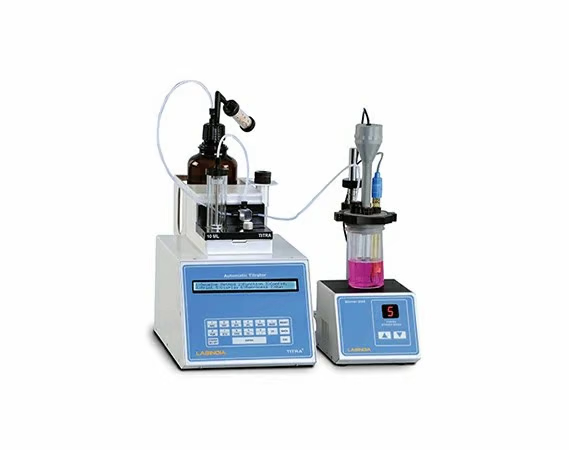Potentiometric Auto Titrator (Titra+)
Labindia Analytical Potentiometric Titrator Titra+ comes with quick interchangeable imported burette assemblies with intelligent recognition for its volume size.This potentiometric autotitrator is perfect for all types of industrial applications. The Titra+ has composite differential electrode amplifier unit for potentiometric and voltametric/Karl Fisher titration having connectivity to various electrodes.
Three standard modes of titration namely incremental, equilibrium and cut-off mode is provided to perform all types of titrations. There is a real time clock for time display and report printout with run time indication. With a balance interface to directly transfer the weight. 50 methods can be stored and report of method parameter can be printed in Titra+.
- Advanced Micro controller based user-friendly, state-of-the-art product design with alphanumeric splash waterproof polyester soft keys for keyboard. User interactive software in dialogue mode for ease of operation with protection against invalid entries.
- Vortex stirrer for vigorous and homogenous stirring with specially designed glass propeller for total chemical inertness.
- Quick interchangeable imported burette assemblies with intelligent recognition for its volume size. Burette factor for dispensing corrections is available for true end point calculations.
- Composite Differential Electrode Amplifier unit for Potentiometric and Voltametric / KF Titrations, having connectivity to various Electrodes. Temperature Sensor with 4-line measurement technique ensures correct temperature indication.
- Three standardised modes of titration, namely incremental, equilibrium and cut-off by pH mode to perform almost all types of titration. By selecting titration method, instrument prints the type of appropriate electrode.
- During titration, the measured variable i.e. electrode potential (mV) or the pH value is shown on the display together with dispensed volume and number of End Points (EP) detected.
- User selectable End Point (EP) evaluation up to 9 EP during the run, and calculation by first, last, largest, all or selected EP with display of results and printout.
- Alphanumeric entry of Sample Name, Titrant Name, Identification Number, Date with type of Electrode used for authentication. Daily Auto Incremented Run number and Factory entered CUSTOMER NAME and Instrument Sr. No. on report printouts make the system foolproof and GLP compliant.
- Facility to use as a dispenser for fixed volume dosing or dilution allows to perform manual titration with user defined dose and mV indication.
- Pre-dispense facility with selectable dose and time for quick titrant addition without disturbing the titration trend.
- Automatic evaluation of molarity for standardisation of titrant, storage of 20 molarities and their retrieval for calculation.
- Compliant to ASTM D664, D2896 & D4739 for TAN and TBN analysis for oil samples.
- Titrant temperature factor for volume correction.
- Result recalculation facility to obtain printout in different units such as molarity, factor, % assay (wt), % volume (ml), ppm, mg/l, mg/g, ml/g, g/l, meq/l, mol/kg, TAN & TBN for oil samples.
- Reprocessing of threshold and recalculation of EP without performing the new run.
- Statistic function with Run Selectivity for finding Mean, S.D., R.S.D., and C.V. of last 10 repeat run results could be viewed or printed.
- User Programmed selectivity for report format, complying with GLP requirements:
- a) Report giving parameter and result.
- b) Data table giving mV, pH, mV, mV/ml, 2nd derivative and volume (µl).
- c) Graphics report giving mV v/s µl titration curve.
- d) Graphics report 1st derivative graph v/s µl titration curve. nd
- e) Graphical report of 2 derivative curve.
- f) Report of method parameters for 50 methods.
- g) Condensed report of titration parameters and results.
- h) Auto evaluation report for multi EP samples - EP1, EP2-EP1 etc. available.
- The reports can be obtained even after resetting/power off/power fail conditions.
- Real Time Clock (RTC) for time display and report printout with run time indication.
- Balance interface to directly transfer the sample weight.
- Two tier - a) Admin and b) User password protection for method editing.
- TITRA can be converted to perform Karl Fischer titrations by simply changing burette assembly. All the specifications of LABINDIA Karl Fischer Titrator are applicable.
|
|
||
|
|
||
|
|
||
|
|
||
|
|
||
|
|
||
|
|
||
|
|
||
|
|
||
|
|
||
|
|
||
|
|
||
|
|
||
|
|
||
|
|
||
|
|
||
|
|
||
|
|
||
|
|
||
|
|
||
|
|
||
|
|
||
|
|
||
|
|
- Data downloading facility to PC via 21CFR compliant EDC21 software.
- IQ, OQ, PQ, documents available.
- Incremental :
- Incremental titration operates with user selectable fixed dose and fixed intervals till the end point is detected or volume limit is reached.
- Equilibrium :
- This is universal and dynamic titration. In this titration the dose and time automatically get tuned to the titration trend with evaluation of end point.
- pH Cut-off/STAT :
- a) In pH cut-off mode, the end point is determined in a pre-selected pH window.
- b) In pH-STAT mode, the pH value is maintained until the pre-selected time inter val is fulfilled
- Acid-base or aqueous titration • Nonaqueous titration
- Redox titration • Argentometric or Precipitation titration
- Complexometric titration or EDTA titration • Voltametric titration / KF Titration
- Blank titration • Back titration
- Silver Assay Titrations (As per BIS 2113 : 2002)
- Pharmaceuticals and Bio-Chemistry • Environmental and Water Pollution
- Food and Beverages • Dyes and Chemicals
- Pesticides and Fertilizers • Petrochemicals, Plastics and Polymers
- Metallurgy and Electroplating •Jewellery Industry

